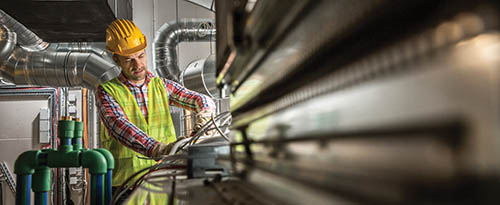— By Scott Stewart & Jack French —
Reduce energy usage this winter without leaving your customers in the cold.
As the cold months of winter set in, restaurant owners and chain store facility managers are tasked with the dual challenge of maintaining a warm and inviting ambiance in their establishments and managing energy costs effectively. This balancing act is essential for creating a comfortable customer environment while ensuring operational efficiency.

This article offers a winter weatherization guide with practical tips designed to help prepare your restaurant for the colder months. These tips aim to optimize warmth and coziness, without incurring excessive energy expenses, thereby ensuring a delightful dining experience for guests and cost-effective operations for the business.
Energy Audits
Conducting an energy audit can help identify potential savings and areas for improvement. While some upgrades may require upfront investment, they can lead to significant long term savings. Researching available incentives, rebates and grants for energy-efficient upgrades can also provide financial relief.
Heating Systems
The maintenance of heating systems is a critical aspect of winter management. It’s important to schedule preventative maintenance for HVAC systems before winter to ensure they run efficiently and safely. Upgrading to more energy-efficient systems can be a wise investment, as modern HVAC systems are more effective in reducing energy costs. Installing smart thermostats can optimize heating schedules, minimizing energy waste when the restaurant is closed.

Insulation and Sealing
Winter weatherization is all about preparing the restaurant or facility to withstand the harsh cold while maintaining operational efficiency. A key to this process is insulation and sealing. Start by inspecting and upgrading the insulation in walls, roofs and floors. Enhanced insulation reduces heat loss significantly, thus lowering energy costs. Sealing gaps around windows and doors with weather stripping or caulking is another effective measure.
Plumbing and Pipes
Winter weather poses significant challenges to plumbing systems with the risk of pipes freezing and bursting in extremely cold temperatures. Insulating pipes, particularly those exposed to external walls or located in unheated spaces, is essential to mitigate these risks. Proper insulation acts as a barrier, reducing the likelihood of the water inside the pipes freezing. Additionally, allowing faucets to drip slightly during periods of extreme cold can keep water moving, thereby preventing it from freezing inside the pipes. In the unfortunate event of a pipe burst, rapid action is crucial to minimize water damage, which is why knowing the exact location of your main water shut-off valve is so important.
Roof and Gutters
Roof and gutter maintenance are equally important. Regular inspections and repairs of the roof help avoid leaks and heat loss. Keeping gutters clear of debris is essential to prevent ice dams, which can lead to substantial water damage. These preventative measures protect your facility from weather-related issues and contribute to overall structural integrity, ensuring your establishments remain safe and efficient for the winter season.
External Debris
It’s essential to regularly remove leaves and other debris from the grilles of outdoor condenser units to prevent blockages and ensure optimal airflow. Keeping these areas clean is vital for efficiently operating your HVAC system. A well-maintained system functions more effectively and enjoys a prolonged lifespan. Additionally, clearing away external debris contributes to lower energy consumption, reducing energy bills. This simple maintenance task is critical in preserving the functionality and efficiency of your heating, ventilation and air conditioning system — ensuring it performs at its best.
Interior Adjustments
Inside the restaurant, installing air curtains over main entrances can keep the cold air out and enhance the overall ambiance. This approach prevents cold drafts and contributes to energy efficiency by maintaining indoor temperatures. Adjusting the interior layout is equally crucial; strategically positioning seating areas away from potential cold drafts near doors and windows can significantly improve customer comfort. Maintaining an optimal humidity level inside the restaurant also ensures a pleasant dining experience. This improves the air quality and creates a more comfortable and inviting environment for patrons.
Energy-Saving Measures
Adopting practices and hardware designed to save energy is another important aspect of winter weatherization. Switching to LED lighting, which is more energy-efficient and emits less heat, can significantly reduce energy costs. Educating staff members on energy-saving practices, such as turning off equipment when not in use and regularly monitoring energy usage, can help identify areas where improvements can be made.
Emergency Power Supply
A reliable emergency power supply is crucial for maintaining essential functions during power outages from extreme winter weather events. Investing in backup power options, such as generators, is wise. Maintaining these generators regularly is necessary to ensure they are always in ready-to-use condition. This includes making routine checks and timely repairs to prevent any malfunctions when they are most needed.
Technology Integrations
Advanced automated systems are crucial to transforming how restaurants manage their day-to-day functions. Automated lighting, heating and security solutions enhance efficiency, providing precise control over these vital aspects of restaurant operations. The use of remote monitoring tools has become a game-changer. These tools empower managers to oversee restaurant and facility conditions remotely, which is particularly useful during non-operating hours or in the face of extreme weather events. This capability ensures that issues can be identified and addressed promptly, even when the manager is not on-site.
Energy Management Software
Further, adopting an energy management system (EMS) marks a significant step toward sustainability and cost-efficiency. This technology allows for the real-time tracking and optimization of energy consumption. By analyzing energy usage patterns, identifying areas where energy is being wasted and taking corrective actions, leading to reduced operational costs and a smaller carbon footprint. The results can be dramatic:
• Wendium, a Wendy’s franchisee in Florida, leveraged our EMS to save 13% in energy costs in the first year just managing its HVAC system and lighting.
• Ampler Holdings, an owner of 347 restaurants, including 80 Burger King locations, uses our EMS to achieve an average monthly reduction of 21.6% kWh of energy, which translates into an average of more than $4,000 in savings per location per year.
• Chipotle restaurants nationwide consistently reduce energy usage by more than 13% during a multi-year period by using our EMS to manage HVAC control, temperature monitoring and asset-level sub-metering, which details energy expenditure of specific equipment pieces including HVAC units, walk-in coolers, kitchen hoods and steam tables.
Proactive Planning Is Key
In conclusion, winter weatherization is an essential part of the smooth operation of restaurants and chain stores during the colder months. Maintaining a regular maintenance schedule is critical. Developing a comprehensive checklist of all winterization tasks to be completed before the onset of cold weather, scheduling regular inspections throughout the winter, and conducting a thorough assessment after winter to identify any damage or areas for improvement are all part of this process.
Through regular maintenance, technological upgrades, proactive planning and consideration for the comfort of employees and customers, facility managers can create a comfortable, safe and energy-efficient environment during winter. This not only enhances the customer experience but also contributes to the sustainability and financial viability across the board.
— Scott Stewart is a senior energy data analyst at GridPoint, a leader in building energy management and optimization technology that decarbonizes commercial buildings and drives grid modernization. Jack French is a senior manager of energy analytics at GridPoint.

